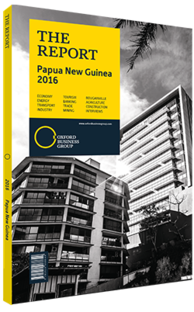Dollar shortage aggravates underlying issues in Papua New Guinea
The country is facing a severe shortage of US dollars, and this has had a direct and significant impact on the economy. Importers are unable to get the funds they need, while insurance companies have faced a loss of reinsurance coverage due to the lack of dollars. Some critics assert that the currency problems are the direct result of a June 2014 decision by the central bank, Bank of Papua New Guinea (BPNG), that has resulted in a sudden strengthening of the kina, according to Mark Baker, managing director PNG at ANZ Banking Broup. BPNG tightened the trading range of the local currency in a bid to narrow the spreads that banks were achieving in the market. The net effect was an overnight appreciation of the kina and a shortage of US dollars. The timing could not have been worse, as commodity prices soon declined.
Dialling For Dollars
In April 2016 the government started discussions with the World Bank’s International Finance Corporation (IFC) regarding a $300m facility to help the country weather the dollar shortage. The idea was highly controversial, and internationally it was criticised due to the perception that the IFC was working outside of its normal areas of responsibility. The problem of “mission creep” made headlines globally as the IFC stepped in to help PNG. Domestically, the programme also ran into trouble. Three major commercial banks operating locally were instrumental to the deal, and while Bank South Pacific (BSP) signed on immediately, the other two banks, ANZ and Westpac, were slow to agree to join the facility. In an April 2016 column for the Australian Financial Review, Matthew Stevens said the issue for the foreign banks was how much capital they would have to put at risk against the new facility. Because the banks’ balance sheets are in a foreign currency – the Australian dollar – additional exposure to kina requires more capital. A kina-based institution, such as BSP, would not encounter this problem. Thus, the exact structure of the facility was seen as a key factor.
Some commentators have come out in support of the deal. In an April 2016 letter to the Financial Times, Danny Leipziger, managing director of the Washington DC-based Growth Dialogue Institute, argued that while the IFC is not the normal channel for this sort of support, it might make sense to allow it to step in in certain instances. He added that there are many instances where the IMF intervenes and it is not the appropriate institution. Local critics, however, have come out against the programme, arguing that what was proposed would not solve the country’s economic problems. Sir Mekere Morauta, a former PM and central bank governor, told Radio New Zealand that the solution is a “band aid” fix that is too small to make a difference. Meanwhile, opposition leader Don Polye told PNG Today that the request for assistance was an indication of government mismanagement.
Self-Curing
Some executives believe the worst may be over. While the backlog in demand for dollars remains high, it appears as though it is building at a much slower rate than before. It only increased from $1.5bn to $1.7bn through the first half of 2016. Robin Fleming, CEO of BSP, told OBG, “At $1.7bn it has not improved markedly, but it also has not deteriorated significantly. But imports have reduced as the market for goods and services has started to taper off.”
In part, this was the result of the markets doing what was expected, as the lack of US dollars means fewer imports. In addition, some of the conditions that led to the shortage are either gone or less severe than before. The Ok Tedi mine came back on-line in early 2016, bringing more dollars into the market, and the drought appears to be reaching an end, helping agricultural exports. While the efforts undertaken by the central bank are relevant, they are not universally seen as the root cause. Some argue that had BPNG not intervened, the situation could have been much worse. “The foreign exchange shortage is a symptom of the problem, not the cause of it,” Baker told OBG.
You have reached the limit of premium articles you can view for free.
Choose from the options below to purchase print or digital editions of our Reports. You can also purchase a website subscription giving you unlimited access to all of our Reports online for 12 months.
If you have already purchased this Report or have a website subscription, please login to continue.


